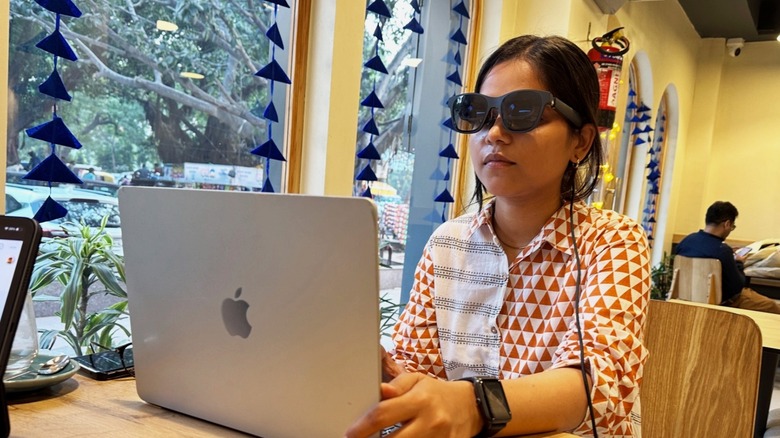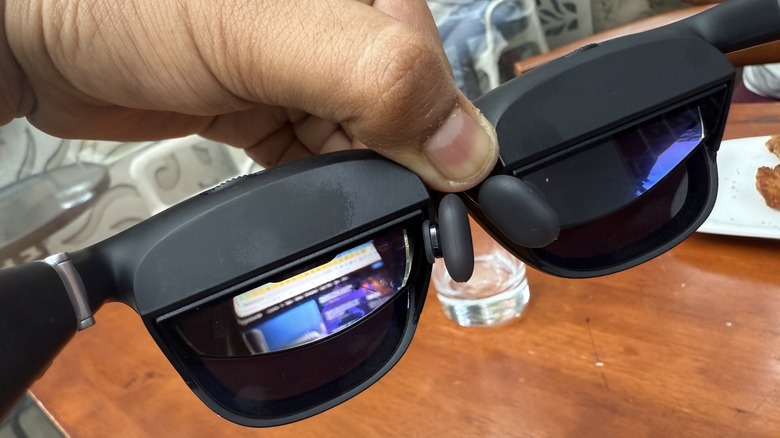Are Smart Glasses A Viable Alternative To Computer Monitors?
Over the past few years, the smart glasses segment has emerged as a lighter and more versatile alternative to headsets. Collectively, virtual reality (VR), augmented reality (AR), and mixed reality (MR) fall under the umbrella term of extended reality (XR). In VR, you have a display unit for watching content, while being cut off from the world. Augmented reality essentially puts an overlay of digital elements over your real-world view. Mixed reality, which is the most advanced and offered on devices such as Meta Quest Pro, turns physical objects into digital elements, blending the real world with virtual world items.
Glasses offered by the likes of Viture and Xreal fall in a rather unique category, as they offer a hint of VR, but with the foundations of AR. Even though these glasses are primarily targeted for watching videos and gaming, they are a solid choice for getting work done, especially if you need a larger screen to go with a laptop or just need more monitors for your desktop. Almost every brand that hawks smart glasses now offers its own software suite that delivers a spatial computing experience, so you're not diving into uncharted territory either.
I work remotely for the most part and direly miss my multi-monitor set-up at times. But thanks to smart glasses, I always have a virtual super-ultrawide screen or multi-monitor setup at my disposal. All you need to do is hook up the glasses with the USB-C port on your laptop, or even an iPad, and you're good to go. It's seamless and works flawlessly. I've managed to get a day's work done on the Xreal Air 2 glasses, while an 11-inch iPad Pro struggled for space on an in-flight seat.
Where they outsmart monitors
There are a whole bunch of advantages when it comes to substituting external screens with smart glasses. Portability and power requirements are the biggest reasons, especially for people who are frequently on the move. Even for my cafe visits, I often carry my RayNeo Air 2S smart glasses, especially for those short bursts of work where I desperately need an extra screen, or two, instead of dealing with cramped app windows and repeated Alt-Tab runs.
The most underrated benefit, however, is the ergonomics. I have a bad posture, and it's somewhat expected for anyone who has spent a healthy few years hunkered over a laptop screen. An ergonomic chair and a monitor mounted straight with my line of sight somewhat helped my posture issues.
But once fixed, there's only so much flexibility you have with fixed or VESA-mounted monitors. With a smart glass, you can set the virtual secondary display to follow your head movement. Alternatively, you can go with a fixed monitor hanging spatially in the air, at a position where your neck and back are in their most comfortable alignment.
Depending on the smart glasses you pick, the companion app will also let you adjust the size, angle, and perceived distance of each virtual display. For me, a curved canvas with two virtual monitors works best. But if you need more, you can stack up two six virtual screens for maximum productivity. On a fun note, the likes of Viture let you convert 2D content into 3D in real time.
Big hits, minor misses
The brightness of the built-in display units and sharpness of full-HD resolution per eye often exceed mainstream monitors, so there's that perk. Plus, most current-gen smart glasses now offer display units with a 90Hz or 120Hz refresh rate, matching the fluidity of gaming monitors. Another massive benefit is the total privacy.
Even with a virtual screen that is over 200 inches in size, or the equivalent of multiple monitors in front of your eyes, there is zero possibility of anyone taking a peek at your on-screen activity. Brands like Xreal and Viture have also started offering glasses with an electrochromic layer, letting you adjust the transparency (or the amount of light passing through) of the front lens. For immersive work, I keep it cranked up to peak.
With a direct USB-C connection, these glasses pair with laptops, consoles, tablets, and phones with ease, offering a large-screen viewing experience on the go, something that's not possible with monitors. But it's all sunshine and rainbows here. In public places, it feels a tad awkward wearing glasses with a cable dangling from the side. Then there's the factor of sensory overload.
Due to their proximity, you definitely want to take them off at least once per hour, or two. The biggest nuisance is the need for lens inserts if you wear prescription glasses. They are comfortable, but a tad bit of a hassle (and added cost). Thankfully, brands such as Viture now offer a per-eye dial that lets you adjust for near-sightedness up to a negative 4D level. Overall, the net convenience makes them a worthwhile investment over monitors.


